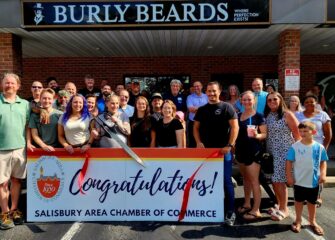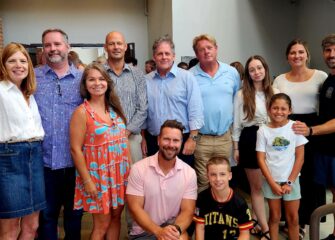
By: Christina Williams of Junior Achievement
Downtowns all over America are seeing a revitalization renaissance, and Salisbury is no exception. According to a Forbes.com 2013 article entitled, Downtowns, What’s Behind America’s Most Surprising Real Estate Boom, the decade following the turn of our century saw a twenty-six percent increase in young, college-educated professionals choosing to live in an urban setting with work, shopping, and entertainment within walking distance. To understand more of this universal drive to inhabit urban settings and the resulting need to breathe new life into old blocks, Junior Achievement sat down and talked with local leader and longtime revitalization advocate, Salisbury city council president, Jake Day.
JA: Why is downtown revitalization important? If there are stores, bars, and restaurants all over Salisbury, why should one small area of the city matter so much?
JD: A downtown is a community’s heart and soul. If we don’t take care of it and invest in our own heart and soul, no one else will. Our core has to represent the best of us, just as what is close to a person’s heart represents what is most important to them. Any visitor to any place in the world will first look to the center to know whether that place is healthy. Similarly, any potential investor or resident will first look to our core to know if we are healthy.
You are right that there are stores and bars and restaurants all over Salisbury. There’s nothing wrong with having certain functions of commerce dispersed throughout an urban area, but Salisbury’s development pattern has played a significant role in our struggling economy. Density of economic activity (employment, exchange of goods and services) and density of capital investment (both private and public) increases the multiplier effect for the economy and it reduces the overall investment and cost of maintaining public infrastructure. In other words, our sprawling, low-density community causes a weaker economy and higher taxes.
A downtown with more shops, more people and more jobs is a nucleus that will generate more economic development pressure outward on the rest of the city and region. A quick glance at every thriving regional economy will show you that in each case they are anchored by one or more vibrant downtowns.
JA: How was it decided that Salisbury’s downtown would be prime for a renaissance? Are there characteristics that make some cities more desirable for a revitalization effort?
JD: It has been decided and re-decided over again on a nearly constant basis every that the statements above always ring true. Since the early 1960’s our downtown has been the focus of redevelopment attention. The difference now is that it is working.
The ingredients that make for a successful revitalization effort are simple but rare: a community that believes in itself, a government that is entrepreneurial and flexible, local leaders that take and inspire action, entrepreneurs that are ready to take risks and open businesses or buy buildings, and an investment community that is prepared to fund them.
JA: What were the driving forces behind the decision to revitalize downtown? Was it a desire to save the existing historic architecture, an economic choice, or something else?
JD: Again, it’s not so much a decision. Every local leader worth his or her salt has had this same goal – the difference is in the results. The driving forces behind it working are the ingredients mentioned above as well as several specific actions that have had a meaningful impact.
Those actions exist at three scales: the tactical, the operational and the strategic. Most efforts exist at one of these scales at the expense of the other two and make claims that “this approach is what we’ve been missing”. Then, the next leader recommends operating at one of the other two scales, and so on. What we are doing now is firing on all three cylinders simultaneously.
At the strategic scale, we make big plans. This is the slow, churning process of plans and action that we expect from government. In Downtown Salisbury we are preparing to adopt the twenty-year Downtown Master plan, we are negotiating a major development on our parking lots, we are about to redevelop the Daily Times property and we are preparing to reconstruct Main Street.
At the operational scale, we see more action at the small business level. We cannot ignore this scale because this is where we see the clearest signs of change. We have seen two new major employers move to downtown; four new retail shops open; and fifteen restaurants open in eighteen months. Transformation is tangible at this scale.
At the tactical scale, we do the small, inexpensive things to breathe life into our city. We are making downtown a community venue, a center of culture. The 3rd Friday events, New Year’s Eve, Easter Egg Hunt, Christmas Tree Lighting, HERO Day, MAXIMA Festival and upcoming Fire on the Water are evidence of this. This also includes the Downtown Trolley, the WhySBY campaign and the Walk of Champions signs.
JA: Drawings and proposals specific to our Salisbury downtown suggest new development in some of the large parking lots. How do you see these modern buildings fitting in with the historic charm of the area?
JD: One mistake many developers, local officials, historic district commissions and advocates make is in focusing on the style of new buildings rather than the urban characteristics of their form. It is more important that a building holds the urban street wall, has lots of openings at the ground level, and is attractive in its own right than that it looks like neighboring buildings. Most importantly, no building should try to mimic or fake an architectural style. Better yet, these modern buildings added to a city should pick up on materials, lines, and features of the historic buildings and use those to build rhythm and a sense of place. Rules should be in place that protect both the historic characteristics of older buildings and enable quality in future buildings.
JA: With new restaurants and shops, a trolley, live music venue, and many community activities, it seems downtown Salisbury is indeed on the road to revitalization. What do you see happening with our downtown in the next ten, twenty, forty years?
JD: It absolutely is coming to life! I believe that if we stay on the right track and don’t make major decisions that counteract our progress, we will see a continued renaissance. In ten years, I see some development on our parking lots and vacant land as well as updated, beautiful streetscapes on many downtown streets. I also see one-hundred percent occupancy in upper floors and several new restaurants at the ground level. In twenty years, I see our major surface parking lots turned into mixed-use developments and many new downtown residents. In forty years, I think we will see a number of areas outside of the traditional downtown area redeveloped to connect to Downtown – including a number of very large new residential and office buildings.
The upsurge in restaurants, residences, and entertainment venues is evidence that the downtown Salisbury renaissance is well underway. With community support and enthusiasm, the vision of a thriving hub of local activity can certainly become this city’s reality.
Christina Williams is the Marketing and P.R. director at Junior Achievement of the Eastern Shore, a 501(c)3 nonprofit dedicated to teaching age-appropriate financial literacy, workforce readiness, and entrepreneurship to over 6,000 local K-12 students annually. Through enthusiastic volunteers and charitable donations from individuals and businesses, Junior Achievement of the Eastern Shore continues its mission to making a difference in our future communities today. www.easternshoreja.org.




